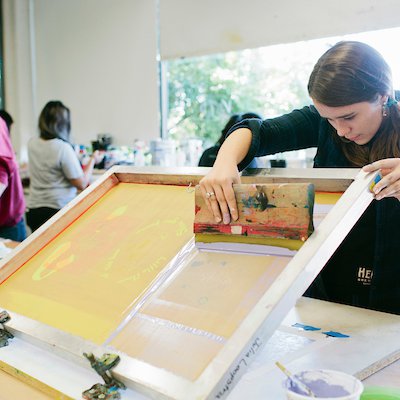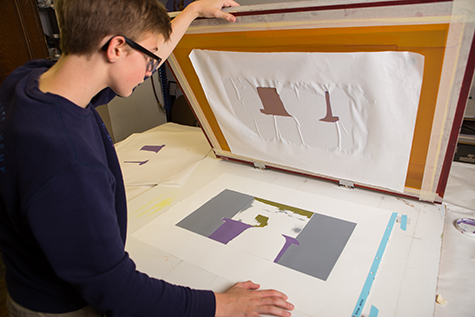Discover the Different Sorts Of Screen Printing Techniques for Your Following Job
Screen printing supplies a varied series of methods that can enhance any type of innovative job. From typical approaches like serigraphy to modern-day innovations such as direct-to-garment printing, each technique has its one-of-a-kind advantages. Specialized choices, including metal and eco-friendly inks, present a lot more opportunities. Understanding these strategies can substantially impact the final outcome. However, the obstacle hinges on picking one of the most appropriate method for specific needs and desired effects. What aspects should one think about?

The Essentials of Screen Printing
Although screen printing may seem facility, it is fundamentally an uncomplicated procedure that involves moving ink with a mesh screen onto various surfaces. The technique begins with the production of a stencil, which defines the style to be published. This pattern is connected to a mesh screen, normally made from polyester or nylon. As soon as the pattern remains in area, ink is related to the screen and pressed through the mesh utilizing a squeegee, leading to the desired pattern being printed on the underlying material.
Screen printing can be carried out on a wide variety of substrates, consisting of material, plastic, and paper, making it a versatile selection for different projects. The procedure enables vivid shades and detailed styles, making it popular in industries such as art, style, and advertising. Understanding these essentials equips individuals with the foundational understanding called for to explore more innovative techniques in screen printing.
Conventional Screen Printing Techniques
Typical screen printing methods have been used for centuries, maintaining the craftsmanship and creativity of this approach. This strategy utilizes a mesh screen to move ink onto a substrate, such as fabric or paper, permitting for lively and lasting designs. The process starts with developing a pattern, which blocks specific areas of the screen to regulate where the ink will be applied.
One prominent technique is serigraphy, commonly used for restricted versions and imaginative prints. An additional is using water-based inks, which are environment-friendly and provide a soft feeling on fabrics - 10:9 Design near me. Additionally, typical techniques can include hands-on printing, where artisans use ink with a squeegee, making sure accuracy and interest to information
These techniques remain valued in the sector for their tactile high quality and the distinct appearances they create, interesting both customers and creators that value the heritage of screen printing.
Digital Screen Printing Innovations
As the need for faster production and personalization in the printing sector has surged, digital screen printing technologies have actually become a game-changer. This innovation mixes typical screen printing methods with digital processes, enabling fast prototyping and detailed designs that were previously challenging to attain. One substantial improvement is the introduction of direct-to-garment (DTG) printing, which facilitates premium, full-color prints on different fabrics without the requirement for screens. Additionally, improvements in ink formulations have led to environmentally friendly choices that preserve vivid shades while reducing ecological impact. Making use of automated systems further simplifies manufacturing, decreasing labor prices and improving precision. These technologies not just deal with tiny set orders and individualized layouts yet also permit for quicker turnaround times, making them perfect for services concentrated on meeting client needs in a hectic market. Digital screen printing, subsequently, represents a necessary development in the domain name of printing techniques.
Specialized Screen Printing Methods
Discovering specialized screen printing methods reveals a varied variety of methods that push the borders of creativity and functionality in the printing sector. Among these, glow-in-the-dark inks give a distinct visual impact, making styles come alive in low-light problems. Metallic inks, understood for their glittering finish, add a touch of deluxe to printed products. An additional innovative method is discharge printing, which gets rid of color from the textile rather than adding ink, resulting in a soft, vintage feel. High-density printing produces an increased texture externally, boosting tactile interaction. Additionally, water-based inks are acquiring popularity for their dynamic shades and reduced environmental impact. Each of these specialized techniques deals with certain layout demands, making it possible for musicians and brand names to produce standout products that reverberate with their audiences. By leveraging these methods, businesses can raise their screen printing jobs to brand-new heights, guaranteeing remarkable impressions.
Eco-Friendly Screen Printing Options
Green screen printing options are getting grip as the industry moves in the visit direction of sustainability. Lasting ink selections and making use of naturally degradable products are essential components in minimizing the environmental effect of the printing procedure. By embracing these techniques, screen printers can add to a more sustainable future while maintaining high-grade outcomes.
Lasting Ink Options

Biodegradable Materials Usage
As the screen printing sector evolves, the incorporation of naturally degradable materials is ending up being increasingly crucial for environmentally mindful practices. Suppliers and designers are currently exploring inks and substrates made from natural, sustainable sources that break down a lot more successfully than traditional counterparts. These naturally degradable alternatives reduce plastic waste and reduce environmental effect, lining up with the expanding need for lasting items.
Usual instances consist of water-based inks and natural cotton textiles, both of which minimize hazardous chemicals and promote eco-friendliness. Brands that embrace these materials commonly enhance their market appeal, attracting consumers who focus on sustainability. As recognition of ecological problems remains to increase, the shift towards biodegradable products in screen printing is most likely to get momentum, promoting a greener industry requirement.
Choosing the Right Technique for Your Job
Exactly how can one identify see this page one of the most appropriate screen printing strategy for a particular project? The decision rests on a number of variables, consisting of the product to be printed on, the complexity of the design, and the desired production quantity - 10:9 Design Company. Direct-to-garment printing is suitable for elaborate designs with countless colors, while conventional screen printing succeeds for larger runs of less complex graphics.
Additionally, consideration of the end-use of the published product is essential. For outside applications, techniques that provide longevity and weather condition resistance, such as plastisol ink, may be chosen. Alternatively, environmentally-conscious projects might take advantage of naturally degradable products or water-based inks.
Ultimately, comprehending the project's special needs permits an educated selection, guaranteeing both aesthetic charm and useful durability. By evaluating design complexity, product compatibility, and manufacturing range, one can properly select the most suitable screen printing method to satisfy their task's goals.
Often Asked Concerns
What Is the History of Screen Printing?
Screen printing came from old China around 1000 AD, developing with Japan and Europe. By the 20th century, it ended up being prominent in industrial art and fashion, transforming exactly how styles were created and distributed internationally.

How Do I Prepare Art Work for Screen Printing?
To prepare artwork for screen printing, one have to guarantee high resolution, use an appropriate shade mode, create separate layers for each color, and convert message to lays out, assuring compatibility with the printing process and preferred result.
What Products Are Best for Screen Printing?
The very best products for screen printing consist of high-quality inks, resilient displays, and ideal substratums like cotton, polyester, or blends. Additionally, using suitable emulsion and mops can improve the printing procedure and last outcomes.
Can I Screen Publish at Home?
Yes, screen printing in your home is possible. With the best materials, setup, and techniques, individuals can create high-grade prints. Nevertheless, cautious factor to consider of work space and tools is essential for address successful outcomes.

What Are Common Errors in Screen Printing?
Typical blunders in screen printing include improper exposure times, insufficient ink consistency, misalignment of screens, not enough cleansing of products, and disregarding to test prints. These errors can jeopardize the top quality and precision of the last item.
Screen printing might appear complicated, it is basically an uncomplicated procedure that entails moving ink with a mesh screen onto different surface areas. As the need for faster production and modification in the printing sector has risen, electronic screen printing developments have actually emerged as a game-changer. Exploring specialty screen printing methods discloses a varied variety of strategies that press the borders of creative thinking and performance in the printing market. The best materials for screen printing include top quality inks, durable displays, and appropriate substrates like cotton, polyester, or blends (10:9 Design Screen Printing). Usual errors in screen printing include inappropriate exposure times, inadequate ink uniformity, misalignment of displays, inadequate cleansing of products, and overlooking to test prints